Unit 4 Body language说课课件
文档属性
| 名称 | Unit 4 Body language说课课件 | 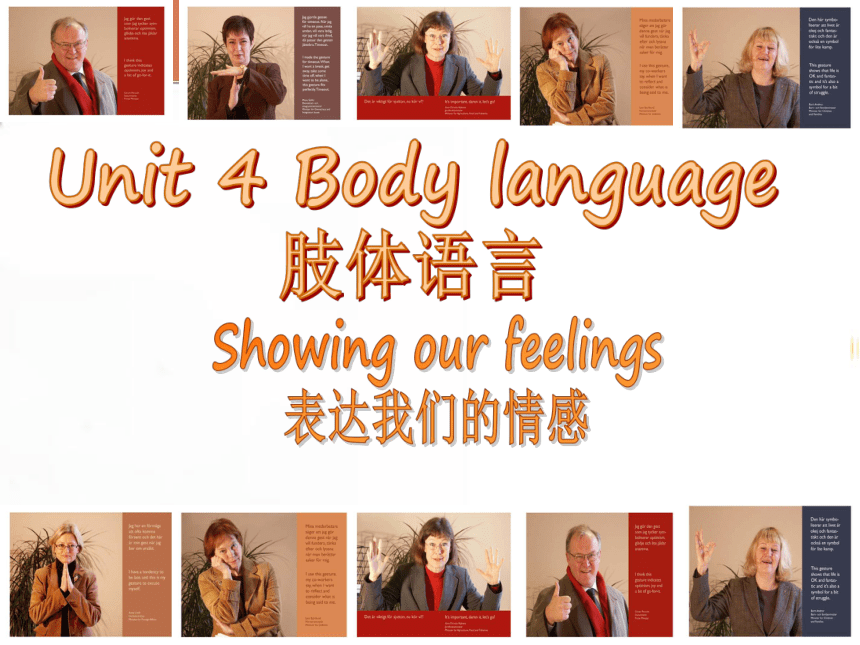 | |
| 格式 | zip | ||
| 文件大小 | 1.1MB | ||
| 资源类型 | 教案 | ||
| 版本资源 | 人教版(新课程标准) | ||
| 科目 | 英语 | ||
| 更新时间 | 2013-04-12 21:48:38 | ||
图片预览

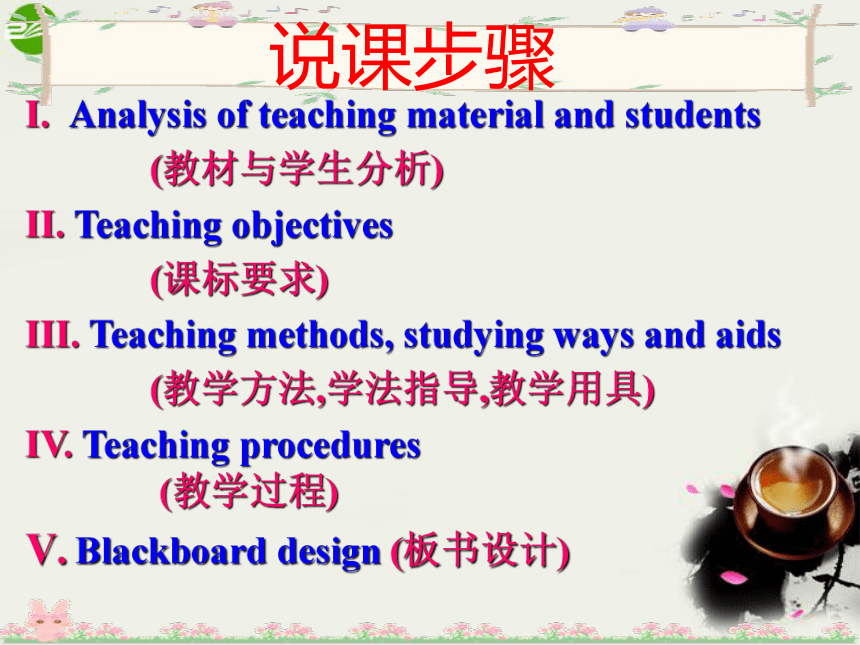
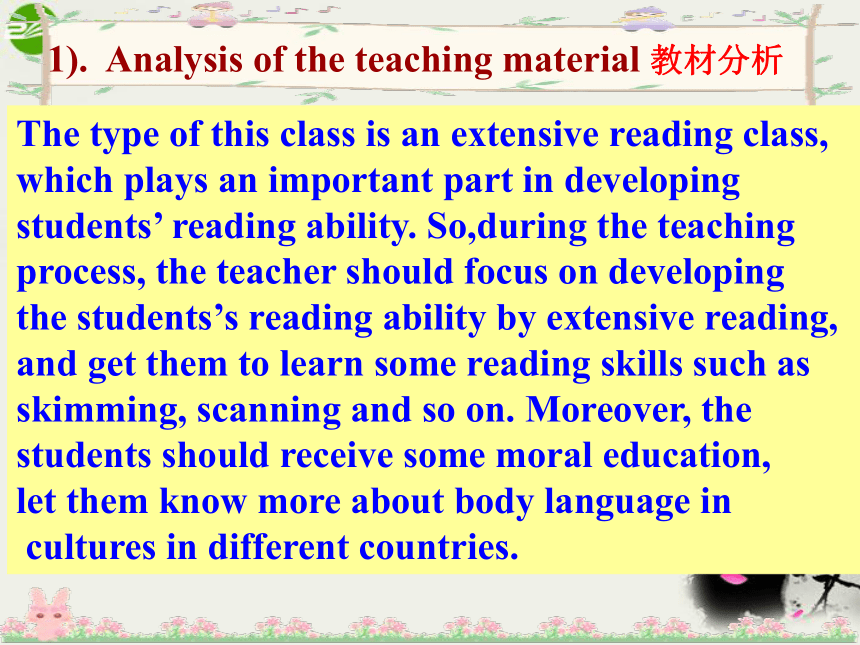

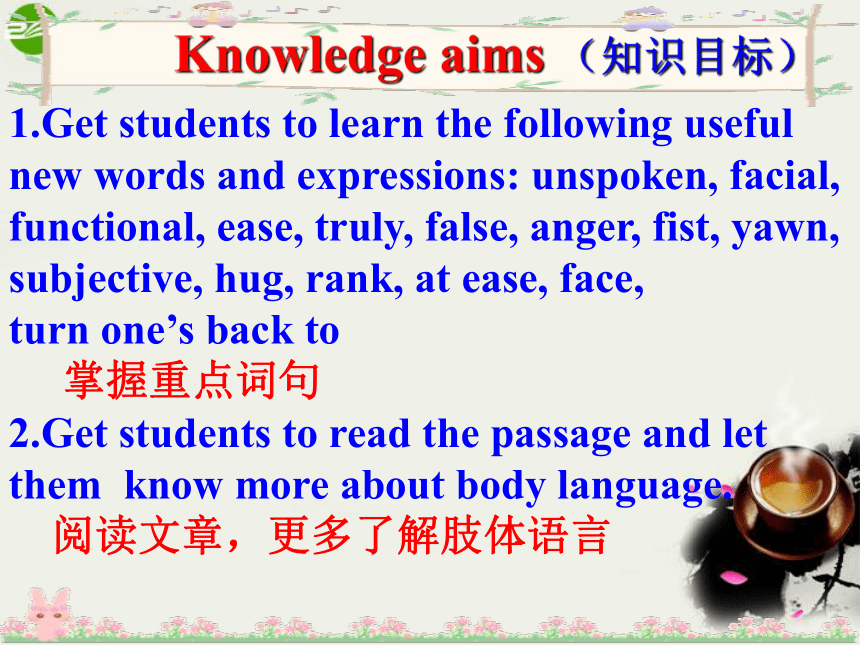

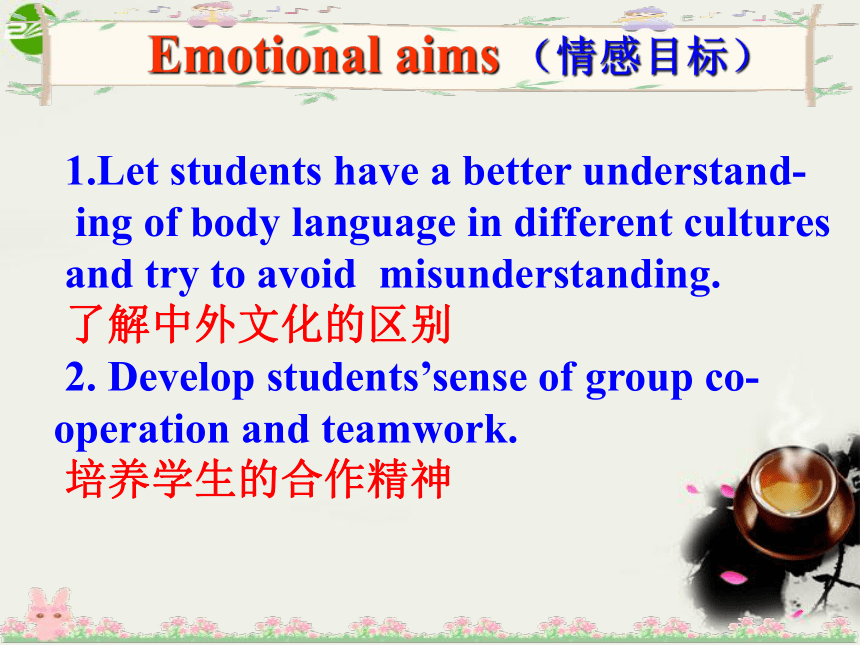
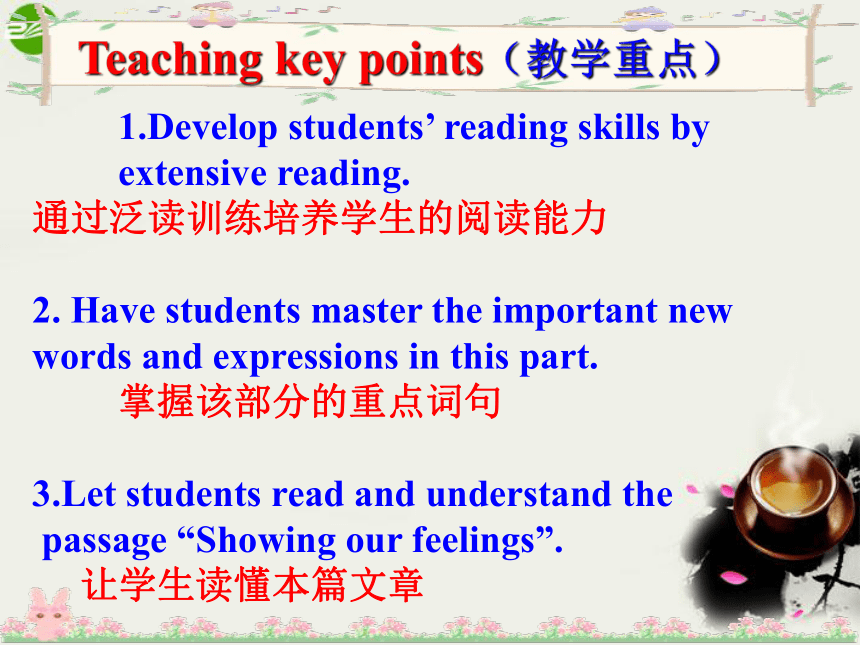
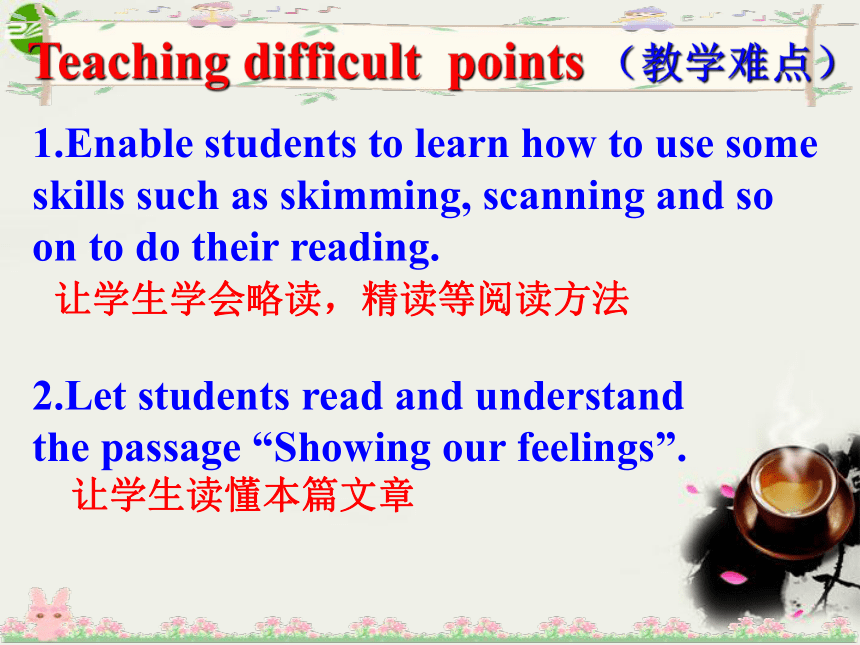
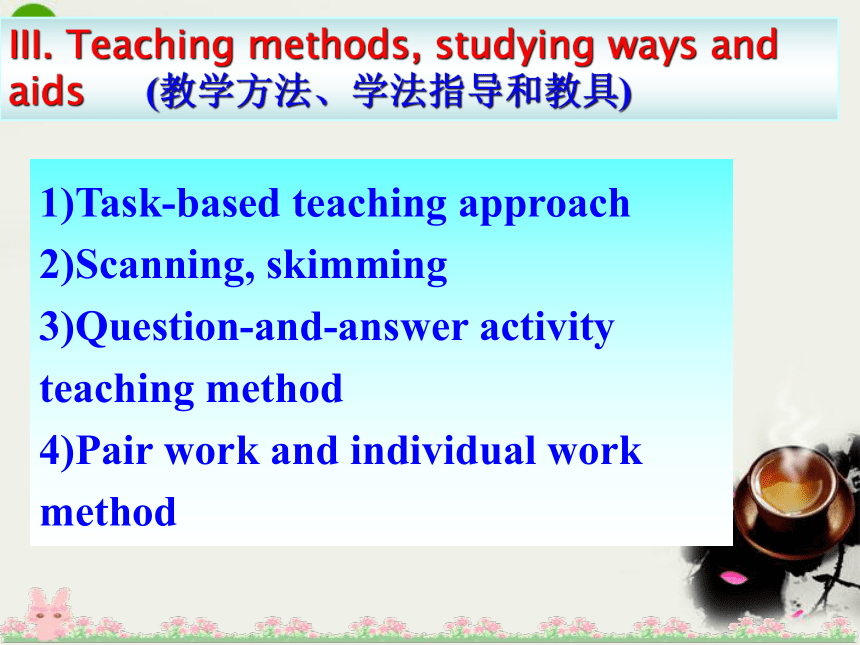

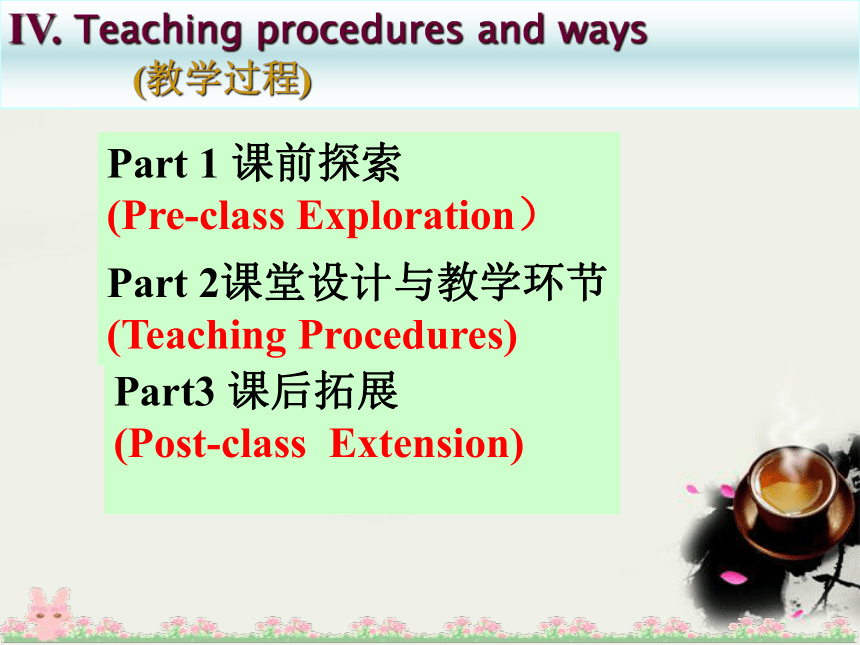
文档简介
课件41张PPT。Unit 4 Body language
肢体语言Showing our feelings
表达我们的情感说课步骤I. Analysis of teaching material and students
(教材与学生分析)
II. Teaching objectives
(课标要求)
III. Teaching methods, studying ways and aids
(教学方法,学法指导,教学用具)
IV. Teaching procedures
(教学过程)
V. Blackboard design (板书设计)
1). Analysis of the teaching material 教材分析The type of this class is an extensive reading class,
which plays an important part in developing
students’ reading ability. So,during the teaching
process, the teacher should focus on developing
the students’s reading ability by extensive reading,
and get them to learn some reading skills such as
skimming, scanning and so on. Moreover, the
students should receive some moral education,
let them know more about body language in
cultures in different countries. 1). Analysis of the students 学生分析As to the students of this class,most of them
are poor in English, they show little interest
in learning English, they are lack of vocabulary
and confidence. So, during the teaching process,
the teacher should focus on how to arouse their
interst in English, moreover, the teacher should
teach them the proper way to learn English and
encourage them to learn English well.Knowledge aims (知识目标)1.Get students to learn the following useful
new words and expressions: unspoken, facial,
functional, ease, truly, false, anger, fist, yawn,
subjective, hug, rank, at ease, face,
turn one’s back to
掌握重点词句
2.Get students to read the passage and let
them know more about body language.
阅读文章,更多了解肢体语言Ability aims (能力目标)Develop students’ reading skills by extensive
reading and enable them to learn how to use
different reading skills to read different reading
materials.
通过泛读训练提高学生的阅读能力
2. Have students know more about and
Understand more about body language.
让学生多了解肢体语言
Emotional aims (情感目标) 1.Let students have a better understand-
ing of body language in different cultures
and try to avoid misunderstanding.
了解中外文化的区别
2. Develop students’sense of group co-
operation and teamwork.
培养学生的合作精神
Teaching key points(教学重点)
1.Develop students’ reading skills by extensive reading.
通过泛读训练培养学生的阅读能力
2. Have students master the important new
words and expressions in this part.
掌握该部分的重点词句
3.Let students read and understand the
passage “Showing our feelings”.
让学生读懂本篇文章Teaching difficult points (教学难点)1.Enable students to learn how to use some skills such as skimming, scanning and so on to do their reading.
让学生学会略读,精读等阅读方法
2.Let students read and understand
the passage “Showing our feelings”.
让学生读懂本篇文章
III. Teaching methods, studying ways and aids (教学方法、学法指导和教具)1)Task-based teaching approach
2)Scanning, skimming
3)Question-and-answer activity teaching method
4)Pair work and individual work methodTeaching aids(教学用具) 1.A multi-media computer
2.Other normal teaching tools
IV. Teaching procedures and ways
(教学过程)Part 1 课前探索
(Pre-class Exploration)
Part 2课堂设计与教学环节
(Teaching Procedures)Part3 课后拓展
(Post-class Extension)
课前探索(Pre-class Exploration):Let students search for more information
about body language which shows different
meanings in different cultures and countries.Aims:Although the students have known something about body language in the first three periods, they may not aware that there may be differences. At the same time,the students can improve their self-learning ability by doing so。Teaching Procedures (课堂设计与教学环节) Step 1. Greeting and revision (课堂问候与复习)
Step 2. Lead- in (导入)
Step 3. Pre- reading (读前)
Step 4. While-reading (读中)
1).Fast reading (快速阅读)
2).Detail reading (细节阅读)
Step 5. Post-reading (读后)
Step 6. Consolidation (巩固)
Step 7. Homework. (作业布置)
Step 1 Greeting and revision
课堂问候与复习 5minsTranslate the following sentences using
the -ing form.
1.我们学校有一个游泳池。
2.站在那边的那个男孩是我的同学。
3.完成工作之后,他就回家去了。
4.大雨滂沱,照成了该地区洪水泛滥。
5.大家认为他是个活字典。Step 2 Lead-in(导入)3mins1.Usually what gestures we
will do ?
2.What’s the meaning of the
following gestures?
3.What’s the meaning of the
following face expressions?Three activities:I am tired.I am full.I am hungry.Usually what gestures we will do ?我们常做的肢势有哪些?Well-doneOk stopquietGestures 手势victory!
Facial expressions(表情) anger
生气 fear
害怕 joy
高兴 sorrow
伤心 contempt
轻视 surprise
惊讶disgust
厌恶Pre-reading
读前Step 3 (2mins) Discussion :1.What is the fun_ction of body language?(肢体语言的作用)
2. What do you think the role of body language in our daily life?(肢体语言的地位)
3. Are all the body language the same in the world? What do you know about them?(所有的肢体语言都是一样吗?)Step 4 While-reading
(读中) 15minsFast-reading
快速阅读Task Find out the topic
sentences of
each paragraph
找出每段的大意 Part 1 (Para 1)
Body language shows all kinds of feelings,
wishes and attitudes and sometimes more
important than spoken language. Part 2 (Para 2-Para6)
Denotation and examples of some body language.Part 3 (Para 7-Para8)
There are differences in body language,
it’s important for us to know them.Read the passage carefully and finish the following reading tasks.
完成下列阅读任务Detail-reading
细节阅读训练阅读
提高语言组织能力Task 1Decide whether the
following statements
true or false
判断对错 1. Body language is never as important as spoken language.
2. If you are angry at a person, you might turn your back to him or her.
3. You can threaten a person by refusing to speak.
4. If you stand with your arms across your body, you are always protecting yourself from being physically attacked.FTFF5. If you sit looking away from a person,or with your back turned, you’re saying you’re not interested in that person.
6. You should not greet your new boss by giving her or him a hug.
7. Body language is the same all over the world.
8. Most people can understand each other if they try.FTTTTask 2Answer the following
question according
to the text
根据课文回答问题1.How can we know others’ feelings, even if they do not speak to us?2.Why should we be careful with our body language?3.Why is it important to watch as well as listen to others?4.What are some jobs in which using body language is extremely important?Task 3 Find some of the body language
which shows similar feelings or
ideas and some which shows
different feelings or ideas in
different cultures.
找出(相)不同的肢体语言所
含的不同含义
文化渗透
情感教育similar body language 1.frowning or turning one’s back to someoneto show anger2. closing one’s hand and shaking it at someoneto threaten that person3. nodding the head up and downto show agreementsimilar body language 4. shaking the head to show disagreement or refusal5. looking away from a person or yawning to show no interest to the person6. standing, holding your arms across your chestto protect yourself from an unwanted conversationsimilar body language 7. sitting, looking at and turning towards the person you are talking to8. rolling your eyes and turn your head awayto show you are interestedto show you do not believe what you hear or you do not like itPost-reading
读后Step 5 10mins Discussion (讨论)How can we know other’s feelings, even if they do not speak to us?
Why should we be careful of our own body language ?
Why is it important to watch others as well as listen to them?培养合作精神Step 6 Consolidation 5mins
(巩固)1.Finish some words and expressions exercises
2.Finish the summary of the passage.
检查教学效果Step 7. Homework (作业布置)Recite the new words and expressions of this part.
2.Read through the passage after class.
Finish off the workbook exercises.
Prepare for the next period.复习提高Part3 课后拓展 (Post-class Extension)
Surf on the Internet, try to know
more about body language and tell
your classmates.
V. Blackboard design (板书设计)1.The main idea of each paragraph2.True or false3. Answer questions4.Differences and similarities in body languageI. Pre-reading II. While-reading III. Post-reading Thank you for listening
肢体语言Showing our feelings
表达我们的情感说课步骤I. Analysis of teaching material and students
(教材与学生分析)
II. Teaching objectives
(课标要求)
III. Teaching methods, studying ways and aids
(教学方法,学法指导,教学用具)
IV. Teaching procedures
(教学过程)
V. Blackboard design (板书设计)
1). Analysis of the teaching material 教材分析The type of this class is an extensive reading class,
which plays an important part in developing
students’ reading ability. So,during the teaching
process, the teacher should focus on developing
the students’s reading ability by extensive reading,
and get them to learn some reading skills such as
skimming, scanning and so on. Moreover, the
students should receive some moral education,
let them know more about body language in
cultures in different countries. 1). Analysis of the students 学生分析As to the students of this class,most of them
are poor in English, they show little interest
in learning English, they are lack of vocabulary
and confidence. So, during the teaching process,
the teacher should focus on how to arouse their
interst in English, moreover, the teacher should
teach them the proper way to learn English and
encourage them to learn English well.Knowledge aims (知识目标)1.Get students to learn the following useful
new words and expressions: unspoken, facial,
functional, ease, truly, false, anger, fist, yawn,
subjective, hug, rank, at ease, face,
turn one’s back to
掌握重点词句
2.Get students to read the passage and let
them know more about body language.
阅读文章,更多了解肢体语言Ability aims (能力目标)Develop students’ reading skills by extensive
reading and enable them to learn how to use
different reading skills to read different reading
materials.
通过泛读训练提高学生的阅读能力
2. Have students know more about and
Understand more about body language.
让学生多了解肢体语言
Emotional aims (情感目标) 1.Let students have a better understand-
ing of body language in different cultures
and try to avoid misunderstanding.
了解中外文化的区别
2. Develop students’sense of group co-
operation and teamwork.
培养学生的合作精神
Teaching key points(教学重点)
1.Develop students’ reading skills by extensive reading.
通过泛读训练培养学生的阅读能力
2. Have students master the important new
words and expressions in this part.
掌握该部分的重点词句
3.Let students read and understand the
passage “Showing our feelings”.
让学生读懂本篇文章Teaching difficult points (教学难点)1.Enable students to learn how to use some skills such as skimming, scanning and so on to do their reading.
让学生学会略读,精读等阅读方法
2.Let students read and understand
the passage “Showing our feelings”.
让学生读懂本篇文章
III. Teaching methods, studying ways and aids (教学方法、学法指导和教具)1)Task-based teaching approach
2)Scanning, skimming
3)Question-and-answer activity teaching method
4)Pair work and individual work methodTeaching aids(教学用具) 1.A multi-media computer
2.Other normal teaching tools
IV. Teaching procedures and ways
(教学过程)Part 1 课前探索
(Pre-class Exploration)
Part 2课堂设计与教学环节
(Teaching Procedures)Part3 课后拓展
(Post-class Extension)
课前探索(Pre-class Exploration):Let students search for more information
about body language which shows different
meanings in different cultures and countries.Aims:Although the students have known something about body language in the first three periods, they may not aware that there may be differences. At the same time,the students can improve their self-learning ability by doing so。Teaching Procedures (课堂设计与教学环节) Step 1. Greeting and revision (课堂问候与复习)
Step 2. Lead- in (导入)
Step 3. Pre- reading (读前)
Step 4. While-reading (读中)
1).Fast reading (快速阅读)
2).Detail reading (细节阅读)
Step 5. Post-reading (读后)
Step 6. Consolidation (巩固)
Step 7. Homework. (作业布置)
Step 1 Greeting and revision
课堂问候与复习 5minsTranslate the following sentences using
the -ing form.
1.我们学校有一个游泳池。
2.站在那边的那个男孩是我的同学。
3.完成工作之后,他就回家去了。
4.大雨滂沱,照成了该地区洪水泛滥。
5.大家认为他是个活字典。Step 2 Lead-in(导入)3mins1.Usually what gestures we
will do ?
2.What’s the meaning of the
following gestures?
3.What’s the meaning of the
following face expressions?Three activities:I am tired.I am full.I am hungry.Usually what gestures we will do ?我们常做的肢势有哪些?Well-doneOk stopquietGestures 手势victory!
Facial expressions(表情) anger
生气 fear
害怕 joy
高兴 sorrow
伤心 contempt
轻视 surprise
惊讶disgust
厌恶Pre-reading
读前Step 3 (2mins) Discussion :1.What is the fun_ction of body language?(肢体语言的作用)
2. What do you think the role of body language in our daily life?(肢体语言的地位)
3. Are all the body language the same in the world? What do you know about them?(所有的肢体语言都是一样吗?)Step 4 While-reading
(读中) 15minsFast-reading
快速阅读Task Find out the topic
sentences of
each paragraph
找出每段的大意 Part 1 (Para 1)
Body language shows all kinds of feelings,
wishes and attitudes and sometimes more
important than spoken language. Part 2 (Para 2-Para6)
Denotation and examples of some body language.Part 3 (Para 7-Para8)
There are differences in body language,
it’s important for us to know them.Read the passage carefully and finish the following reading tasks.
完成下列阅读任务Detail-reading
细节阅读训练阅读
提高语言组织能力Task 1Decide whether the
following statements
true or false
判断对错 1. Body language is never as important as spoken language.
2. If you are angry at a person, you might turn your back to him or her.
3. You can threaten a person by refusing to speak.
4. If you stand with your arms across your body, you are always protecting yourself from being physically attacked.FTFF5. If you sit looking away from a person,or with your back turned, you’re saying you’re not interested in that person.
6. You should not greet your new boss by giving her or him a hug.
7. Body language is the same all over the world.
8. Most people can understand each other if they try.FTTTTask 2Answer the following
question according
to the text
根据课文回答问题1.How can we know others’ feelings, even if they do not speak to us?2.Why should we be careful with our body language?3.Why is it important to watch as well as listen to others?4.What are some jobs in which using body language is extremely important?Task 3 Find some of the body language
which shows similar feelings or
ideas and some which shows
different feelings or ideas in
different cultures.
找出(相)不同的肢体语言所
含的不同含义
文化渗透
情感教育similar body language 1.frowning or turning one’s back to someoneto show anger2. closing one’s hand and shaking it at someoneto threaten that person3. nodding the head up and downto show agreementsimilar body language 4. shaking the head to show disagreement or refusal5. looking away from a person or yawning to show no interest to the person6. standing, holding your arms across your chestto protect yourself from an unwanted conversationsimilar body language 7. sitting, looking at and turning towards the person you are talking to8. rolling your eyes and turn your head awayto show you are interestedto show you do not believe what you hear or you do not like itPost-reading
读后Step 5 10mins Discussion (讨论)How can we know other’s feelings, even if they do not speak to us?
Why should we be careful of our own body language ?
Why is it important to watch others as well as listen to them?培养合作精神Step 6 Consolidation 5mins
(巩固)1.Finish some words and expressions exercises
2.Finish the summary of the passage.
检查教学效果Step 7. Homework (作业布置)Recite the new words and expressions of this part.
2.Read through the passage after class.
Finish off the workbook exercises.
Prepare for the next period.复习提高Part3 课后拓展 (Post-class Extension)
Surf on the Internet, try to know
more about body language and tell
your classmates.
V. Blackboard design (板书设计)1.The main idea of each paragraph2.True or false3. Answer questions4.Differences and similarities in body languageI. Pre-reading II. While-reading III. Post-reading Thank you for listening
同课章节目录
